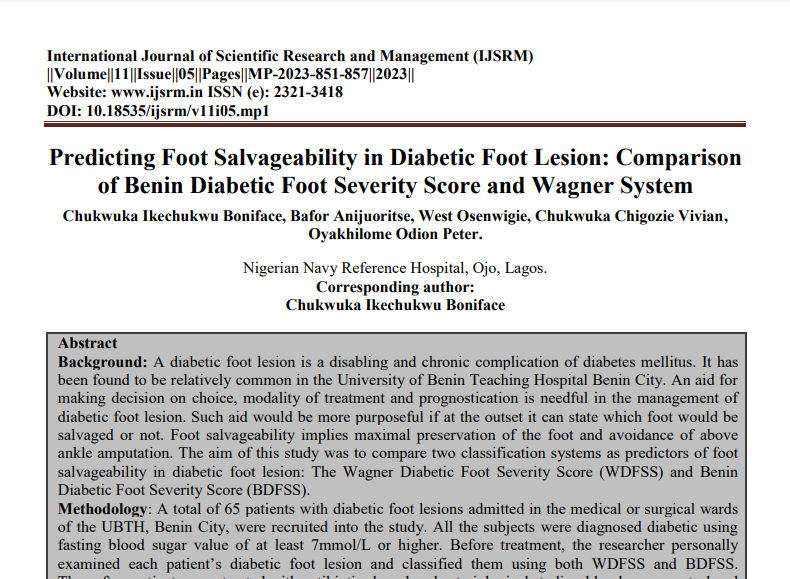Predicting Foot Salvageability in Diabetic Foot Lesion: Comparison of Benin Diabetic Foot Severity Score and Wagner System

Submission to VIJ 2023-05-29
Keywords
- Diabetic foot, WDFSS, BDFSS, Diabetes mellitus, foot lesions
Copyright (c) 2023 Chukwuka Ikechukwu Boniface, Bafor Anijuoritse, West Osenwigie, Chukwuka Chigozie Vivian, Oyakhilome Odion Peter

This work is licensed under a Creative Commons Attribution 4.0 International License.
Abstract
BACKGROUND: A diabetic foot lesion is a disabling and chronic complication of diabetes mellitus. It has been found to be relatively common in the University of Benin Teaching Hospital Benin City. An aid for making decision on choice, modality of treatment and prognostication is needful in the management of diabetic foot lesion. Such aid would be more purposeful if at the outset it can state which foot would be salvaged or not. Foot salvageability implies maximal preservation of the foot and avoidance of above ankle amputation. The aim of this study was to compare two classification systems as predictors of foot salvageability in diabetic foot lesion: The Wagner Diabetic Foot Severity Score (WDFSS) and Benin Diabetic Foot Severity Score (BDFSS).
METHODOLOGY: A total of 65 patients with diabetic foot lesions admitted in the medical or surgical wards of the UBTH, Benin City, were recruited into the study. All the subjects were diagnosed diabetic using fasting blood sugar value of at least 7mmol/L or higher. Before treatment, the researcher personally examined each patient’s diabetic foot lesion and classified them using both WDFSS and BDFSS. Thereafter, patients were treated with antibiotics based on bacteriological studies, blood sugar control and wound care using basic surgical principles. Daily wound dressing was done using normal saline. During the period of treatment, the patients were evaluated by the researcher at 2 weekly intervals, using the WDFSS and BDFSS. The desired outcomes of treatment included successful foot salvage (avoidance of amputation above the ankle) or failure to salvage the foot ending in below knee amputation. Age, sex, duration of diabetes mellitus, clinical findings of the diabetic foot lesion such as skin colour, ulcer grade, sensation and presence or absence of peripheral pulses, radiological features of the foot and ankle were all documented. The outcome of treatment based on the stage or state of the foot lesion was also noted. The data obtained was analyzed as both descriptive and inferential methods using SPSS version 20.0 statistical software. Logical argument and Receiver Operating Curve were also used.
RESULTS: BDFSS had greater AUC of 0.928 than WDFSS with AUC of 0.78. BDFSS recorded a higher degree of 95% confidence interval of 85% to 99% as against WDFSS with 95% confidence interval of 66% to 90%. Also, BDFSS recorded a higher sensitivity 95% as against WDFSS with sensitivity of 79%. Additionally, BDFSS has a greater Specificity of 87% as against WDFSS with Specificity of 73%. A bivariate logistic regression analysis was performed to assess which characteristic and clinical variables were independently associated with outcome using variables with P< 0.01 according to the univariate analysis.
CONCLUSION: This study demonstrated that the BDFSS has acceptable accuracy and capacity for predicting diabetic foot lesion outcome. BDFSS in this study was found to be comparable to the WDFSS thereby making it a useful tool in clinical practice and research both for the anticipation of health care cost and for comparing patient subgroups.
References
- Global Report on Diabetes: Preventing Diabetes Vol. 978, World Health Organizaiton, 2016. (Accessed 03-05-2017, at http://www.who.int/bitstream/10665.pdf.)
- Neves J. Diabetic Foot Infections: Current Diagnosis and Treatment. 2012. 45-47 p.
- World Health Organization. Diabetes Mellitus. Report of a WHO Study Group. Geneva. Vol. 727, WHO - Technical Report Series;727. 1985. p. 1–113.
- Oyibo SO, Jude EB. Outcome of Ischaemic Foot Ulcers in Patients with Diabetes, with or without Revascularization. PubMed. 2016;8(2):82–94.
- Sicree BR, Shaw J, Zimmet P. The Global Burden Diabetes and Impaired Glucose Tolerance. IDF Diabetes Atlas. 2010; (Fourth Edition):1–105.
- Levin ME. An Overview of the Diabetic Foot : Pathogenesis , Management and Prevention of Lesions. Int J Diabetes Dev Ctries. 1994;14(2):39–47.
- Bafor A. Akinyemi O. Limb amputations at a Tertiary Hospital in the Developing World: A Look at Pattern and Indications. African J Trop Med Biomed Res. 2014;3(1):17–21.
- 8. Umebese PFA, Ogbemudia OA. Management of Diabetic Foot: Objective Results in 40 Patients using a new Diabetic Foot Severity Score. Nig J Surg. 1998;5(1):10–2.
- Choi MSS, Lee JH. Predictive factors for successful limb salvage surgery in diabetic foot patients. BMC Surg. 2014; 14: 113.
- Chuan F, Tang K, Jiang P, Zhou B, He X. Reliability and validity of the perfusion, extent, depth, infection and sensation (PEDIS) classification system and score in patients with diabetic foot ulcer. PLoS One. 2015;10(4):1–9.
- Balducci S, Sacchetti M, Haxhi J, Orlando G, D’Errico V, Fallucca S, Menini S, Pugliese G. Physical Exercise as therapy for type II diabetes. Diabetes Metab Res Rev 2014;32(30):13–23.
- Shashikala CK, Vedavathi K. Validation of diabetic ulcer severity score. Int Surg J. 2016;3(3):1509–16.
- Ngim NE, Ndifon WO, Udosen AM, Ikpeme IA, Isiwele E. Lower limb amputation in diabetic foot disease: experience in a tertiary hospital in southern Nigeria. African J Diabetes Med. 2012;20(1):13–23.
- Nwadiaro HC, Puepet FH, Ike EI, Kidmas AT. Prognostic indices of diabetic foot disease. Nig J Orth & Tr 2003; 7: 84 – 89.